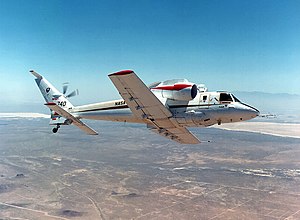Sikorsky S-72
| S-72 RSRA | |
|---|---|

| |
| The S-72 in flight without a main rotor in 1984 | |
| Role | Experimental helicopter |
| Manufacturer | Sikorsky Aircraft |
| First flight | 12 October 1976 |
| Number built | 2 |
The Sikorsky S-72 was an experimental hybrid helicopter/fixed-wing aircraft developed by helicopter manufacturer Sikorsky Aircraft.
Design and development
RSRA
The Rotor Systems Research Aircraft (RSRA) was developed by Sikorsky for NASA and the Army. The RSRA was developed to allow the in-flight measurement of helicopter rotor characteristics. The airframe was developed using an existing Sikorsky S-61 main rotor, an S-61 roller gearbox, and a highly modified Sikorsky S-67 airframe. The RSRA could be fitted with TF34 turbofans and wings to allow compound helicopter configurations to be experimentally investigated at speeds up to 300 knots (560 km/h). In addition, it could fly as a fixed-wing aircraft without a rotor.[1][2][3]
Unique among helicopters of its time, it was fitted with a crew emergency extraction system. This system, when activated, fired explosive bolts that severed the main rotor blades, egress panels were blown off the roof of the aircraft and then the crew was extracted using rockets.[4]
The RSRA was a unique pure research aircraft developed to fill the void between design analysis, wind tunnel testing, and flight results of rotor aircraft. The joint NASA/Army project began in December 1970, first flight on October 12, 1976 with the first of two aircraft arriving from Sikorsky to NASA on February 11, 1979.
One notable test performed with the RSRA was the use of the main and tail rotor load measurement system to determine the vertical drag of the airframe.[5]
In 1981, NASA and the US Army solicited proposals for fitting a four-bladed main rotor to the RSRA. Sikorsky proposed fitting a UH-60A main rotor to the RSRA in their proposal,[6] while Hughes Helicopters proposed fitting a YAH-64A main rotor[7] and Boeing Vertol proposed fitting a YUH-61A or Model 347 (4-blade CH-47) main rotor.[8] In the end, this program did not proceed.
The X-Wing


The X-Wing circulation control rotor concept was developed in the mid-1970s by David W. Taylor Naval Ship Research and Development Center under DARPA funding.[9] In October 1976, Lockheed Corporation won a DARPA contract to develop a large-scale rotor to test the concept.[10]
Intended to take off vertically like a helicopter, the craft's rigid rotors could be stopped in mid-flight to act as X-shaped wings to provide additional lift during forward flight, as well as having more conventional wings. Instead of controlling lift by altering the angle-of-attack of its blades as more conventional helicopters do, the craft used compressed air fed from the engines and expelled from its blades to generate a virtual wing surface, similar to blown flaps on a conventional platform. Computerized valves made sure the compressed air came from the correct edge of the rotor, the correct edge changing as the rotor rotated.[11]
In late 1983 Sikorsky received a contract to modify one S-72 RSRA into a demonstration test bed for the X-Wing rotor system. The modified airframe was rolled out in 1986, but never flew before the program was cancelled in 1988.[12][13][14]
Specifications (S-72)
General characteristics
- Crew: 2-3
- Take-off weight without auxiliary jets: 8,300 kg
- Empty weight without auxiliary jets: 6,535 kg
Performance
See also
Related development
Aircraft of comparable role, configuration, and era
Related lists
References
- ^ A conceptual study of the rotor systems research aircraft. NASA. 1972. hdl:2060/19720025371.[page needed]
- ^ Schmidt, Steven A.; Linden, Arthur W. (1972). Rotor systems research aircraft predesign study. Volume 2: Conceptual study report. NASA. hdl:2060/19720025365.[page needed]
- ^ Schmidt, Steven A.; Linden, Arthur W. (1972). Rotor systems research aircraft predesign study. Volume 3: Predesign report. NASA. hdl:2060/19720025366.[page needed]
- ^ Bement, L. J. (1978). Rotor Systems Research Aircraft Emergency Escape System. 34th Annual National Forum. American Helicopter Society.
- ^ Flemming, R. J. (1981). RSRA vertical drag test report. NASA. hdl:2060/19820024465.[page needed]
- ^ Davis, S. J. (1981). Predesign study for a modern 4-bladed rotor for RSRA. NASA. hdl:2060/19830004795.[page needed]
- ^ Hughes, C. W.; Logan, A. H. (1981). Pre-design study for a modern four-bladed rotor for the Rotor System Research Aircraft (RSRA). NASA. hdl:2060/19820008170.[page needed]
- ^ Bishop, H. E.; Burkam, J. E.; Heminway, R. C.; Keys, C. N.; Smith, K. E.; Smith, J. H.; Staley, J. A. (1981). Predesign study for a modern 4-bladed rotor for the NASA rotor systems research aircraft. NASA. hdl:2060/19820008169.[page needed]
- ^ Warwick, Graham (August 9, 2008). "X-Wing". DARPA 50th Anniversary Gallery. Aviation Week & Space Technology. Retrieved October 26, 2012.
- ^ Carlisle, Rodney P. (1998). Where the Fleet Begins: A History of the David Taylor Research Center, 1898-1998. Department of the Navy. pp. 373–9. ISBN 0-160494-427.
- ^ Reader, Kenneth R; Wilkerson, Joseph B (2008) [1976]. Circulation Control Applied to a High Speed Helicopter Rotor. David W. Taylor Naval Ship Research and Development Center.[page needed]
- ^ "X-Wing scheduled to fly in October" (PDF). Flight International: 18. 22 February 1986.
- ^ "X-wing". Retrieved October 26, 2012.[unreliable source?]
- ^ "Darpa ditches X-Wing" (PDF). Flight International: 2. 16 January 1988.
External links
- X-Wing Research Vehicle on NASA.gov
- S-72 on helis.com
- Robb, Raymond L. (2006). Hybrid helicopters: Compounding the quest for speed, Vertiflite. Summer 2006. American Helicopter Society. Size: 25 pages in 2MB. Archive
